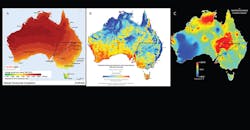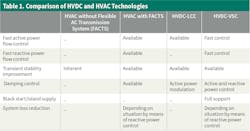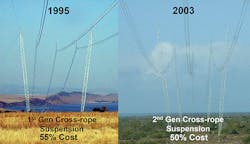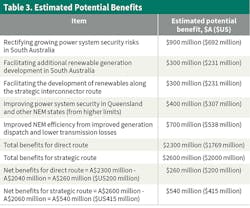The Australian National Electricity Market comprises the five interconnected states of Queensland, New South Wales, Victoria, Tasmania and South Australia. It is one of the longest alternating current (AC) power systems in the world — stretching 5000 km (3100 miles) from North Queensland to South Australia — running over a relatively weak transmission system and passing sequentially through Queensland, New South Wales, Victoria and South Australia. The transmission system experiences congestion and high transmission losses, which restrict the free flow and interstate trading of electrical energy in the Australian National Electricity Market (NEM).
It is feasible to directly interconnect the existing South Australian and Queensland grids, which would halve the distance between Queensland and South Australia as well as bypass high transmission losses and congestion on the existing grid through the other states. Developing this NEM interconnector would also alleviate the current high pool prices and enable further development of Australia’s renewable energy resources, including wind power in South Australia, solar power in Queensland, and geothermal and solar power in the large outback region of Central Australia, which are not yet developed.
Need for Interconnection
Located at the extremities of the national grid, South Australia and Queensland can experience high pool prices up to A$14,000/MWh (US$10,700/MWh) because of binding constraints on their single interconnector imports. Serious concerns about the security of the South Australian power system have come about because of closures in conventional power stations, attributed to a rapid growth in renewable generation. These closures resulted in low synchronous generation and inertia, which contributed to the South Australian blackout following an interconnector trip in September 2016. The effective interconnector capacity into Queensland is only 4% of its average maximum electricity demand, which severely restricts the import of competitively priced renewable energy from other NEM states.
South Australia’s excellent wind-power resources and Queensland’s excellent solar photovoltaic resources are seeing unprecedented development. This has compounded power system security concerns nationally because of the grid-weakening effects of large amounts of inverter-connected renewables displacing conventional synchronous generators on a long, weak power system. Both the Queensland and South Australian governments have committed to 50% renewable electricity generation targets by 2025 and 2030, respectively.
Route Alternatives
Two alternative routes were under consideration for the proposed new interconnector:
1. Direct route from South Australia to Queensland, passing through northwest New South Wales, over a distance of 1400 km (870 miles).
2. Strategic route through the undeveloped renewable energy resources in Central Australia over some 1600 km (1000 miles).
The strategic route passes through undeveloped geothermal energy resources in Central Australia as well as areas of high solar energy potential. There are also better wind-power resources along the strategic route as well as substantial natural gas and undeveloped liquefied natural gas resources.
The remoteness and land use along the strategic route also may enable consideration of innovative transmission line designs such as guyed chainette structures like those installed in Quebec, Canada, in the 1970s and, more recently, in Namibia. These twin-guyed mast structures, with a cross rope that supports the conductor bundles, have delivered excellent performance, such as the lowest tower fault rate in South Africa. In addition to reduced cost and construction time, advantages include high electric strength, elimination of bird pollution, excellent shielding from lightning and a reduced tower footprint.
After preliminary evaluation of alternative connection points for the new interconnector, it was concluded the Queensland connection should be at the 330-kV Bulli Creek substation and the South Australian connection at the 275-kV Davenport substation. The Bulli Creek connection also increases the stability limits of the existing 330-kVAC Queensland-to-New South Wales interconnection by using the new high-voltage direct-current and voltage source converter (HVDC-VSC) interconnector to damp oscillations on the existing high-voltage AC (HVAC) interconnection.
The Davenport substation is a strategic point on the South Australian grid, close to undeveloped wind-power resources and the transmission supply point for the Olympic Dam uranium mines, already the second largest in the world and is being considered for expansion. Connecting a new HVDC-VSC interconnector at Davenport would significantly increase the low fault levels in northern South Australia, which have become a serious power system security issue.
Technology Choice
The following technology choices were considered for the proposed interconnector:
• HVAC
• HVDC-line compensating converters (LCC)
• HVDC-VSC
Given the 1400-km (870-mile) and 1600-km (1000-miles) transmission distances for the project, it is unquestionable HVDC is more economical than HVAC. And the DC alternative could be delivered at a 20% savings in capital cost.
Both HVDC-LCC and HVDC-VSC are technically feasible technologies for voltages up to 500 kV based on HVDC-VSC experience. However, previous Australian interconnector studies have discounted HVDC-VSC technology because of its immaturity, higher costs and transmission losses compared with LCC technology. Recent advances have reduced these disadvantages, and HVDC-VSC is now the interconnector technology of choice in Europe and China to strengthen power systems weakened by the rapid introduction of inverter-connected renewable generation. Since 2010, more than 15 HVDC-VSC schemes have been commissioned in more than 10 countries with voltages up to 500 kV, capacities up to 2000 MW and transmission distances up to 1000 km (620 miles). Based on the benefits of the HVDC-VSC and ability to connect additional terminal stations along the interconnector route over time, HVDC-VSC was selected as the best proven technology for this project.
Capacity and Voltage
The International Council on Large Electric Systems (CIGRÉ) HVDC Working Group has estimated how the annualized cost varies with interconnector length, load-transfer capacity and voltage for HVDC transmission lines. The costs include the transmission line, terminal station, transmission losses, and annual operation and maintenance costs. The results indicate it would not be economical to adopt 500 kV as the operating voltage unless the required load-transfer capacity exceeded 1200 MW and the circuit length was greater than 1500 km (930 miles). To date, the highest-voltage HVDC-VSC interconnectors have been the 350-kV Caprivi interconnector in Namibia (2010) and the 500-kV Skagerrak 4 interconnection between Norway and Denmark (2015).
The interconnector capacity for South Australia likely will be governed by the South Australian power system withstanding the tripping of a single interconnector circuit without causing undue load shedding. Currently the largest acceptable contingency for South Australia, without causing load shedding, is the loss of a 235-MW generator in Pelican Point power station. Assuming a bi-pole design where only one 350-MW pole would trip for a credible contingency, the maximum interconnector capacity could be around 700 MW (or two 350-MW poles).
Having a second interconnector to South Australia with a capacity of 700 MW would duplicate the existing AC interconnection capacity and provide a total interconnection capacity that would equal the average maximum demand on the South Australian grid system. It would enable South Australia to install additional renewable generation capacity (wind and solar power) as well as alleviate the existing interconnection congestion and power system security concerns.
The average demand in Queensland is around 6000 MW, with a system maximum demand of 9000 MW. The existing HVAC interconnector with New South Wales is usually limited to 300 MW import when Queensland is at maximum demand, so a new 700-MW interconnector would increase Queensland’s total import capacity to 1000 MW, being some 15% of the average demand.
Preliminary design calculations indicate a 700-MW interconnector capacity and a voltage of ±350 kV to ±400 kV could deliver an efficient line design with two conductors per pole that optimizes the capital cost, transmission loss and corona. A preliminary study of conductor sizes concluded twin 637-mm2 (1-inch2) Sulphur all-aluminum alloy conductors would limit the interconnector voltage drop and conductor losses to around 10% when operating at the design load-transfer capacity of 700 MW.
Future Renewable Generation
Consideration has been given to the future development of renewable generation along the route of the interconnector by installing an additional HVDC-VSC terminal or more in Central Australia with a capacity of up to 700 MW each that could be transmitted to either South Australia or Queensland. HVDC-VSC is not restricted to point-to-point transmission as it is technically feasible to have multiple terminals along the interconnector, for example, the five-terminal Zhoushan Island HVDC-VSC scheme in China.
The additional cost of the terminal station would be more than justified by the higher solar intensity in Central Australia.
Estimated Costs
The capital cost for the direct and strategic routes have been estimated using published data and Australian transmission projects that reflect Australian labor costs, standards and allowances for site work at remote locations. Even though the direct route is shorter than the strategic route, it traverses more cultivated land that would require more expensive freestanding transmission towers, because the land use is unsuitable for guyed chainette structures. Easement costs also would be greater for the direct route.
The net present value (NPV) of the operation and maintenance costs over the asset life of the interconnector have been estimated to be $A200 million ($US154 million) for both routes. These estimates include routine inspections, line patrols, easement and access track maintenance, and corrective and emergency repairs.
Transmission losses — for example, conductor resistive losses, corona losses and HVDC-VSC converter losses — have been estimated assuming balanced power flows between South Australia and Queensland. The capitalized cost of losses over the asset life cycle of the interconnector have been estimated to be $A420 million ($US323 million) and $A460 million ($US354 million) for the direct and strategic routes, respectively.
Summarizing the capital costs, operation and maintenance, and transmission loss estimates gives a total estimated life-cycle cost of $A2040 million ($US1569 million) for the direct route and $A2060 million ($US1585 million) for the strategic route.
Potential Benefits
Indicative financial benefits of the interconnector have been estimated from high-level analyses and the results from previous interconnector studies. The total estimated benefits amount to $A2300 million ($US1769 million) for the direct route and $A2600 million ($US2000 million) for the strategic route.
Based on the preliminary assessment, the net benefits for the direct route are $A260 million ($US200 million), some 13% of the total life-cycle costs. For the strategic route, the net benefits are A$540 million ($US415 million), or 26% of the total life-cycle costs.
The interconnector also would deliver these five unquantified benefits:
1. Help to achieve government renewable energy targets
2. Create additional employment opportunities
3. Stimulate the economy of regional communities
4. Prove the viability of low-cost, long distance HVDC-VSC transmission for Australia’s remote renewables
5. Increase the competitiveness and security of the NEM as well as reduce wholesale electricity price volatility.
Preliminary Assessment
Based on the preliminary assessment, it was concluded that HVDC-VSC technology is the most suitable choice for an interconnector across Australia, from South Australia to Queensland. The technical parameters, such as capacity, voltage, number and type of conductors, have been selected to enable the cost and performance of the interconnector to be determined. Two alternative routes have been compared along with interconnection points to the existing grids in South Australia and Queensland. The most financially beneficial one is the strategic route, which provides greater potential to exploit the renewable energy resources in Central Australia in the future.
Interconnector transmission losses were estimated to average around 10%. This confirms the preliminary design is prudent and efficient, balancing lower capital cost against life-cycle transmission losses. The cost-benefit analysis shows the strategic route interconnector’s capital cost of $A1400 million ($US1077 million) would be justified fully by the benefits and deliver net benefits of 26% of the life-cycle cost, whereas the direct route only would deliver net benefits of 13% of the life-cycle cost.
Professor Simon Bartlett AM ([email protected].) is managing director of ARCMesh Pty Ltd and the Australian Power Institute’s Australian Chair of Energy Innovovation. He has 40 years of experience in power generation and transmission in Australia, Europe and North America, including as chief operating officer of Powerlink Queensland, director of ElectraNet South Australia, a member of the Australian Energy Market Commission’s Reliability Panel and the Australian Energy Market Operator National Electricity Market Operating Committee. He was named the Australian Professional Engineer of 2008 and awarded a Member of the Order of Australia in 2012 for services to Australia’s power industry.
About the Author
Simon Bartlett
Professor Simon Bartlett ([email protected]), AM, is an Australian electrical engineer with 40 years of experience in power system planning, operations and management, including as COO, CEO and Board Director of electric power utilities and professional associations. His industry contributions have been recognized by awards of Member of the Order of Australia (AM) and Australian Professional Engineer of the Year. As project director of the University of Queensland Solar Enablement Initiative, Bartlett provides leadership and inspiration.









